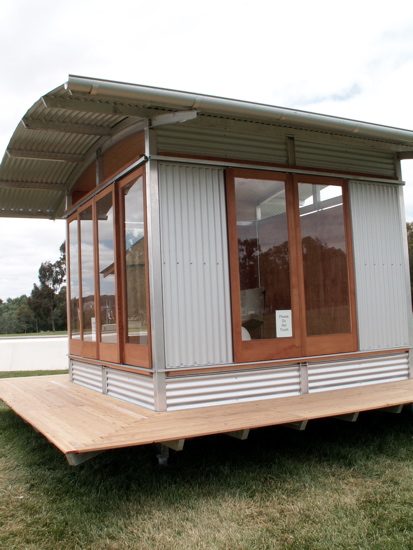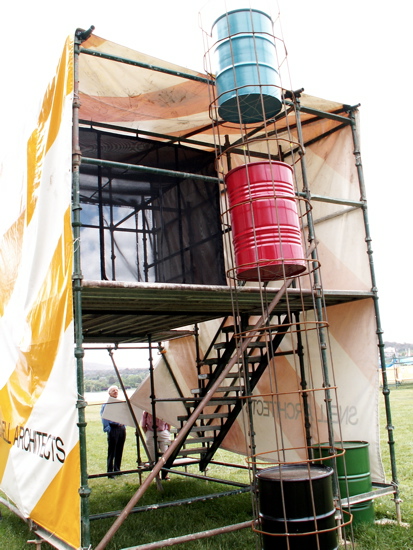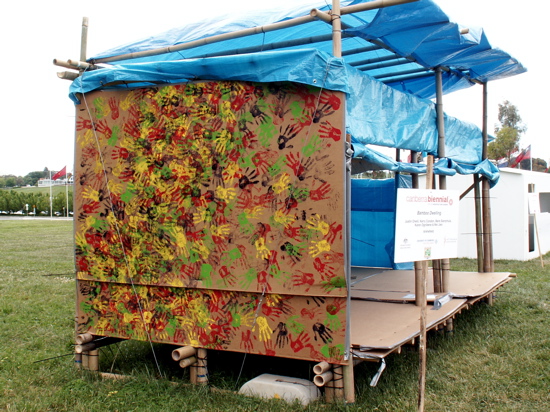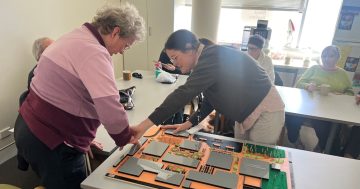The first ever Canberra Biennial is on right now with an exhibition at Reconciliation Place of temporary shelters (the theme for this biennial). There have also been various conferences and talks (have a look here for more on this). The exhibition closes this Sunday 20-NOV-05 but if you don’t have time to wander over there, I took some pictures the other weekend.
And so I now present “Canberra Biennial: the virtual tour”.

The first structure was fairly permanent looking (actually, a fair few of them were) wood and corrugated iron single room. I think it may have been on a trailer, but I didn’t investigate thoroughly.

There was a pretty neat chair inside this place (I have learned an appreciation for chairs over the past few years).

And outside the building were some of those cool plastic rock-seats that you can fit together however you want (complete with familiar shirt…). I’m reasonably sure these were designed by a graduate of the University of Canberra’s industrial design course.

The next structure was a wooden tent-like creation with a long canopy for a balcony (note another cool chair in this one too — I think they may have had some significance but I didn’t get close enough to read any of the signs).

After this was a raised single bed made from scaffolding and tent canvas. Now, having camped several times in Coober Pedy, I could see the appeal of this, but JB thought it was rather heavy and a waste of effort to put up for only a single bed and a bit of storage space.

And this is more or less what it would look like if you were in the bed.

Next to this was another thing made from scaffolding that I thought looked rather like a two-storey stage. Not sure what the oil drums were for (this is taken from behind the structure) but they certainly added interest.

The next one drew lots of complaints due to its lack of shelter provision (remember, the theme of the exhibition is temporary shelters). I liked it though.

Next to the wooden stage thing was a shelter made from bamboo, blue plastic and cardboard.

I was skeptical about how strong the floor was (and didn’t try walking on it), but because of the blue plastic the inside had a calming effect what with all that blue light.

The next shelter was my favourite. The idea behind this one was that it could pack down flat and be posted.

And inside it had a matching dog house.

Probably the most market-ready-looking structure was this uniquely-shaped caravan. Inside were two single beds and some storage space.

And the second-least sheltering shelter (after the stage thing) had to be this — basically a twisted carboard box. I think you’d have to be pretty skinny to fit inside and I wouldn’t rely on it on anything but clear, still nights.

Next were two yurts all the way from Mongolia (if I remember the CT story properly). They arrived late — something to do with planes and customs or something — and were put up with the help of some Chinese labourers from a nearby construction site. They were very bright and I’m told they were quite comfortable inside.

The last of the structures was another well-built wooden hut, complete with water tank.

Inside there was a small loft area which looked to me like where you’d sleep.

And finally, the shelter given to the plans of the other, unbuilt entries to this exhibition of temporary shelters amused JB no end.






















